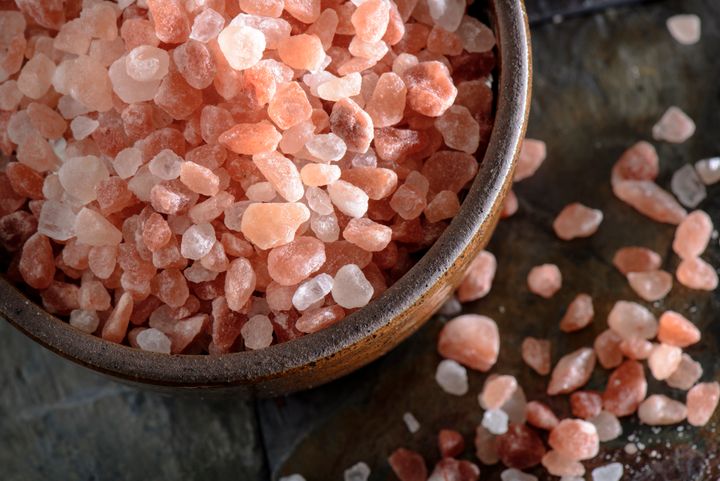
Hawaiian black lava, Himalayan pink, Bolivian rose, Peruvian pink mountain spring. These aren’t nail polish colors — they’re varieties of salt, and they’re just a sampling of the dozens of options now available from specialty markets and online vendors. Sea salts and other finishing salts have grown popular among chefs and foodies, who use them to add interesting flavor notes and a pop of color to dishes. They offer more complexity than standard table salt, which is processed to remove minerals and other harmless impurities, giving the salt its bright white color and uniform texture.
But trendy artisanal salts aren’t just being positioned as more flavorful. Many producers and aficionados claim that sea salts are healthier than table salt because they’re more natural and less refined. They’re also praised for containing a bounty of essential trace minerals. And the alleged advantages don’t stop there. Company websites promise that sea salts can eliminate toxins, balance the body’s pH, boost circulation, enhance digestive health, and supply antioxidants, to name a few purported benefits.
Seeing Through Sea Salt’s Healthy Hype
These lavish claims aren’t supported by science. Specialty salt purveyors, like so many other food companies, are playing into many consumers’ belief that natural must mean better for you. But from a health perspective, salt is salt, and eating too much of it in any form can increase the risk for high blood pressure and other downstream health problems. Also, salt isn’t a good source of minerals like calcium, magnesium, and potassium. The miniscule amounts it contains don’t make a dent in your body’s requirements. Relying on salt as a mineral source is equivalent to eating white pasta to boost your fiber intake or guzzling honey to get more magnesium and iron in your diet — it’s just not efficient, nor is it health-promoting.
Marketing salt as unrefined creates an undeserved health halo. When grains are refined from their whole form, there is a substantial loss in nutritional value. That’s not the case with refined salts because salt isn’t a meaningful source of nutrients to begin with (except sodium and its partner chloride, of course). The same goes for unrefined sugars like evaporated cane juice and date sugar. And the glorification of unrefined salts and sugars takes the focus off the truly important issue: that people need to eat less of these ingredients. While health authorities still disagree about optimal sodium intake for adults and how low recommendations should go, it’s clear that we are currently consuming too much.
Whether you prefer regular table salt, kosher, or fancier varieties, it’s important to use salt judiciously. In my experience, it’s easy to get carried away with salts that come in large crystals or flakes because a light sprinkling of granules looks sparse, but actually supplies a lot of sodium. My advice is to use all salt sparingly and consciously underseason your food so you can gradually adjust to using less. As an avid home cook myself, I know it can be a struggle, but it will serve your heart well in the long run.
Salt: The Iodine Question
One major difference between table salt and specialty salts is the iodine content. Standard table salt is voluntarily fortified with iodine, a mineral that’s essential for normal thyroid function (a quarter teaspoon supplies about 50 percent of the 150 micrograms adults need daily). Other varieties, including kosher and sea salts, are not fortified and therefore supply no iodine. The vast majority of salt used in processed foods also has no added iodine. Iodized salt isn’t the only source of the nutrient, however. Fish and shellfish, dairy products, bread and other grain products, and eggs supply iodine as well. Federal survey data shows that most Americans have adequate iodine levels, but some populations are at risk for low intake.
Women who are pregnant or breastfeeding need extra iodine (220 and 290 micrograms, respectively), and approximately one-third of pregnant women in the United States are marginally deficient. Iodine is critical for babies’ growth and cognitive development, so it’s important to get enough. The American Thyroid Association recommends that women who are pregnant, breastfeeding, or planning to become pregnant take a prenatal vitamin that includes 150 micrograms of iodine in the form of potassium iodide. If you are currently taking a prenatal supplement, review the label to determine if contains iodine, because some formulations still do not.
As a group, strict vegans appear to have lower iodine levels compared to vegetarians and omnivores because many of the richest sources are of animal origin. One good plant-based option is seaweed, which can be consumed in sushi rolls, salads, or even the crunchy baked snacks that are now sold by some mainstream companies. Seaweed can be highly concentrated in iodine, but the amount is variable among different types, and you need to eat it consistently, several times a week, for it to be a significant source. Consuming excessive amounts can provide too much of the mineral, so it’s important not to go to extremes.
Unfortunately, there is no reliable way to assess an individual’s iodine level, so if you’re concerned, it’s best to work with a registered dietitian or well-informed physician to determine if you might benefit from a supplement. For individuals who may have a low iodine intake, using iodized salt in place of other varieties when cooking is a good idea, but it’s not a reason to sprinkle on more salt.
Is Sea Salt Really Healthier or Just Overhyped? was originally published on Everyday Health.
More from Everyday Health:
9 Need-to-Know Facts About Salt
5 Healthy Food Trends That Are Worth the Splurge
Where Nutritionists Go to Spot Food Trends
11 Ways to Kick the Salt Habit
Also on HuffPost:
